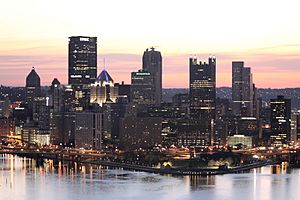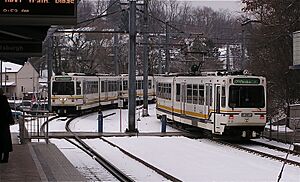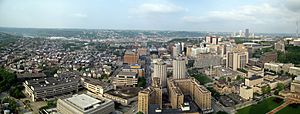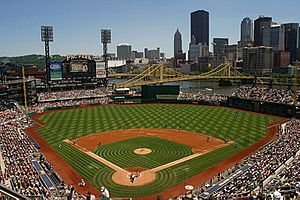Greater Pittsburgh facts for kids
Quick facts for kids
Greater Pittsburgh
Pittsburgh, PA Metropolitan Statistical Area
|
|
|---|---|

Downtown Pittsburgh in November 2011
|
|
| Country | |
| State | |
| Largest city | Pittsburgh |
| Population | |
| • Total | 2,457,000 |
| • Rank | 26th in the U.S. |
| GDP | |
| • MSA | $181.5 billion (2022) |
| Time zone | UTC−05:00 (Eastern Standard Time) |
| • Summer (DST) | UTC−04:00 (Eastern Daylight Time) |
Greater Pittsburgh is the large area around the city of Pittsburgh in Western Pennsylvania, United States. It includes Allegheny County, which is Pittsburgh's main urban and economic center. It also includes seven nearby counties in Pennsylvania. These are Armstrong, Beaver, Butler, Fayette, Lawrence, Washington, and Westmoreland. This whole area is officially called the Pittsburgh, PA Metropolitan Statistical Area (MSA).
In 2020, over 2.37 million people lived in the Greater Pittsburgh region. Pittsburgh itself has about 302,971 residents. This makes it the second-largest city in Pennsylvania, after Philadelphia. More than half of the region's population lives in Allegheny County. This county has 1.24 million people and is the second-largest county in the state.
Contents
Understanding the Pittsburgh Region
| Historical population | |||
|---|---|---|---|
| Census | Pop. | %± | |
| 1850 | 13,829 | — | |
| 1860 | 178,831 | 1,193.2% | |
| 1870 | 262,204 | 46.6% | |
| 1880 | 355,869 | 35.7% | |
| 1890 | 664,778 | 86.8% | |
| 1900 | 1,083,846 | 63.0% | |
| 1910 | 1,471,800 | 35.8% | |
| 1920 | 1,759,989 | 19.6% | |
| 1930 | 2,023,269 | 15.0% | |
| 1940 | 2,062,556 | 1.9% | |
| 1950 | 2,213,236 | 7.3% | |
| 1960 | 2,768,938 | 25.1% | |
| 1970 | 2,759,443 | −0.3% | |
| 1980 | 2,648,991 | −4.0% | |
| 1990 | 2,468,289 | −6.8% | |
| 2000 | 2,431,087 | −1.5% | |
| 2010 | 2,356,285 | −3.1% | |
| 2020 | 2,370,930 | 0.6% | |
| U.S. Decennial Census 1790–1960 1900–1990 1990–2000 |
|||
Experts like Garrett Nelson and Alasdair Rae studied how people travel to work in 2016. They found that the "Pittsburgh megaregion" is a huge area. It includes parts of 54 counties in Western Pennsylvania, Eastern Ohio, Northern West Virginia, and Western Maryland. This means the region covers the central part of the Allegheny Plateau. It is west and north of the Allegheny Front. It is also south of Lake Erie and Pennsylvania's Northern Tier.
The areas along the Upper Ohio River and its many eastern rivers, like the Allegheny and Monongahela, have always been where most people live. This research shows that the U.S. can be divided into "megaregions." These are based on how far people commute, up to 100 miles from a main city.
By this broad definition, the Pittsburgh megaregion includes 28 counties in Pennsylvania. It also has 19 counties in West Virginia, 5 in Ohio, and 2 in Maryland. It even includes a small part of New York. In 2016, over 4.9 million people lived in this large megaregion.
There are also official ways to define Greater Pittsburgh. These are often used in the news. They include the Pittsburgh, PA Metropolitan Statistical Area (MSA). There is also the Pittsburgh-New Castle-Weirton, PA-OH-WV Combined Statistical Area (CSA). The Nielsen Corporation's Pittsburgh Designated Market Area (DMA) is another common definition.
Nineteen counties are part of at least one of these definitions. In 2016, their total population was over 2.9 million.
| County | State | Formal Definition | Population
(2016) |
||
|---|---|---|---|---|---|
| MSA | CSA | DMA | |||
| Allegheny | PA | 1,225,365 | |||
| Armstrong | PA | 66,486 | |||
| Beaver | PA | 167,429 | |||
| Brooke | WV | 22,977 | |||
| Butler | PA | 186,847 | |||
| Clarion | PA | 38,513 | |||
| Fayette | PA | 132,733 | |||
| Forest | PA | 7,321 | |||
| Garrett | MD | 29,425 | |||
| Greene | PA | 37,197 | |||
| Hancock | WV | 29,590 | |||
| Indiana | PA | 86,364 | |||
| Jefferson | OH | 66,704 | |||
| Lawrence | PA | 87,294 | |||
| Mercer | PA | 109,972 | |||
| Monongalia | WV | 104,622 | |||
| Preston | WV | 33,758 | |||
| Venango | PA | 52,582 | |||
| Washington | PA | 207,981 | |||
| Westmoreland | PA | 355,458 | |||
| Total Population | 2,938,646 | ||||
Economy and Connections
Pittsburgh was once known as part of the "Rust Belt." This term described areas that lost many factory jobs. However, the region has grown a lot recently. Now, it's seen as part of the "Great Lakes Basin." This means it's connected to the economy of the Great Lakes area.
Pittsburgh's economy is strongly linked to cities like Cleveland, Erie, Toledo, and Detroit. An economist named Christopher Briem says that southwestern Pennsylvania is more connected to northeastern Ohio than to eastern Pennsylvania. He points out that Pittsburgh's industries are tied to Ohio cities like Youngstown and Akron.
He even made up the word "Cleveburgh" to describe the strong connection between Cleveland and Pittsburgh. This shows how much these cities rely on each other. Experts also call the area between Cleveland and Pittsburgh the "Steel Corridor." This highlights their shared history in the steel industry.
Learning and Education
The biggest school system in the area is the Pittsburgh Public Schools. Many other public school districts serve Allegheny County. There are also many private schools in Allegheny County.
You can find more public school districts in Beaver, Westmoreland, and Washington counties. Each of these counties also has private schools.
The region is home to many colleges and universities. In Pittsburgh itself, some famous ones are Carnegie Mellon University, the University of Pittsburgh, and Duquesne University. Other colleges in the city include Carlow University and Chatham University.
Outside the city, but still in the greater area, you'll find universities like Clarion University of Pennsylvania and Slippery Rock University. There are also Robert Morris University and Washington & Jefferson College. Many other schools offer different types of learning.
Getting Around: Transportation
Airports for Travel
Pittsburgh International Airport (IATA: PIT) is about 17 miles west of downtown Pittsburgh. It's the main airport for the area. A smaller airport, Arnold Palmer Regional Airport (IATA: LBE), is east of downtown in Latrobe. It also offers commercial flights.
Pittsburgh International used to be a major hub for US Airways. In 2000, it had over 500 flights daily. Even after US Airways reduced flights, the airport has seen more service from other airlines. These include JetBlue and Southwest Airlines. Delta Air Lines even offers direct flights to Paris.
Arnold Palmer Regional Airport has flights from Spirit Airlines. These flights go to places in the Carolinas, Florida, and Texas. This airport has had scheduled flights since the 1980s.
Allegheny County Airport (IATA: AGC) is in West Mifflin, Pennsylvania. It's the largest airport for private planes in the area. Its historic terminal was the main passenger airport until 1952. Allegheny Airport opened in 1931. It was one of the first airports with "hard surface" runways.
Smaller airports in the suburbs are used for private and corporate jets.
- North Metro:
- Butler County Airport
- Zelienople Municipal Airport
- Rock Airport
- New Castle Municipal Airport
- Lakehill Airport
- Grove City Airport
- South Metro:
- Allegheny County Airport
- Rostraver Airport
- Joseph A. Hardy Connellsville Airport
- Washington County Airport
- East Metro:
- Pittsburgh-Monroeville Airport
- Greensburg Jeannette Regional Airport
- Indiana County-Jimmy Stewart Airport
- Arnold Palmer Regional Airport
- West Metro:
- Beaver County Airport
- Eddie Dew Memorial Airpark (Ohio)
- Jefferson County Airpark (Ohio)
- Herron Airport (West Virginia)
- Wheeling Airport (West Virginia)
Major Highways
The Pittsburgh area has four main Interstate highways. The Pennsylvania Turnpike is one of them. It is also known as I-76.
There are also several shorter Interstate routes:
 I-376
I-376 I-576 (future)
I-576 (future) I-279
I-279 I-579
I-579
Other Important Roads
 US 22 helps people commute from Steubenville, Ohio. It goes through West Virginia and into Washington County, Pennsylvania.
US 22 helps people commute from Steubenville, Ohio. It goes through West Virginia and into Washington County, Pennsylvania. US 30 runs through the Greensburg area. It also joins I-376 through Pittsburgh.
US 30 runs through the Greensburg area. It also joins I-376 through Pittsburgh. US 119
US 119 US 422
US 422 SR 7 follows the Ohio River in Ohio.
SR 7 follows the Ohio River in Ohio. PA 28 serves commuters in the Allegheny Valley. It goes through Armstrong County.
PA 28 serves commuters in the Allegheny Valley. It goes through Armstrong County. Toll PA 43 (Mon–Fayette Expressway) is a 70-mile toll road. It connects the south hills to West Virginia.
Toll PA 43 (Mon–Fayette Expressway) is a 70-mile toll road. It connects the south hills to West Virginia. PA 65 serves commuters along the Ohio River valley. It is northwest of the city.
PA 65 serves commuters along the Ohio River valley. It is northwest of the city. Toll PA 66 (Amos K. Hutchinson Bypass) is a partial beltway for traffic. It helps traffic from I-70 and the Pennsylvania Turnpike.
Toll PA 66 (Amos K. Hutchinson Bypass) is a partial beltway for traffic. It helps traffic from I-70 and the Pennsylvania Turnpike.- Fort Duquesne Boulevard is a downtown expressway. It connects I-279 and I-579.
River Port
The Port of Pittsburgh is a very busy port. It ranks as the 21st-largest port in the United States. In 2011, it handled almost 34 million short tons of river cargo. It is the 9th-largest in the U.S. for trade within the country.
Public Transportation

The Pittsburgh Regional Transit (PRT) is the biggest public transport service. It has a 26-mile subway/light rail system. This system serves the central part of the area. Other transit services connect to different directions. These include the Butler Transit Authority to the north.
Train Services
Amtrak trains serve the region. They stop at Penn Station in Downtown Pittsburgh. There are also stops in Connellsville, Greensburg, and Latrobe.
Freight trains are also very important here. The Pittsburgh Line and the Conway Yard are key parts of the rail system.
Bus Services
Both Greyhound Lines and Megabus offer bus services in the area.
Outdoor Fun: Trails and Recreation
- Deckers Creek Trail
- Great Allegheny Passage
- Mon River Trail
- Montour Trail
- Ohio River Trail
- Ohio River Water Trail
- Panhandle Trail
- Stavich Bike Trail
- Three Rivers Heritage Trail
- West Penn Trail
- Western Maryland Rail Trail
- Westmoreland Heritage Trail
- Wheeling Heritage Trails
Culture and Identity
Pittsburgh and its surrounding area have a unique identity. It's often seen as a mix between the Northeastern and Midwestern United States. The region's counties are also part of Appalachia. This is a mountain region defined by the Appalachian Regional Commission.
Pittsburgh is sometimes called the "northern urban industrial anchor of Appalachia." This is unusual because much of Appalachia is rural and has faced economic challenges.
Joseph Scarpaci, a geography professor, says Pittsburgh has "one foot in the East...and the other in the Midwest." Barbara Johnstone, a professor at Carnegie Mellon University, explains this unique culture. She says it was hard to travel through the Allegheny Mountains. This made the area feel isolated.
Brian O'Neill, a writer, wrote a book called The Paris of Appalachia. He talks about Pittsburgh's unique identity. He suggests that Pittsburgh should embrace being "The Paris of Appalachia." He believes the city is not truly Midwestern or East Coast. It is simply Pittsburgh, a place unlike any other.
Arts and Creativity
Visual Arts Scene
Greater Pittsburgh has many museums, galleries, and groups that celebrate visual arts. The biggest art museum is the Carnegie Museum of Art. It was started in 1895 by Andrew Carnegie. It's in Pittsburgh's Oakland neighborhood. It's famous for its collections of 19th and 20th-century decorative art. It also has Japanese prints and old master prints.
For modern art, you can visit the Mattress Factory and Andy Warhol Museum. Both are on Pittsburgh's North Side.
Other art museums in the region include:
- Frick Art and Historical Center (Point Breeze, Pittsburgh)
- Contemporary Craft (Strip District, Pittsburgh)
- ToonSeum (Downtown, Pittsburgh)
- Westmoreland Museum of American Art (Greensburg)
- Southern Alleghenies Museum of Art (Multiple locations - Loretto, Ligonier Valley, Johnstown, and Altoona)
- The Maridon Museum (Butler)
- University Museum at Indiana University of Pennsylvania (Indiana)
- Hoyt Institute of Fine Arts (New Castle)
- Venango Museum of Art, Science, and Industry (Oil City)
- Palmer Museum of Art (University Park)
- Erie Art Museum (Erie)
- Juniata College Museum of Art (Huntingdon)
- Art Museum of West Virginia University (Morgantown)
Sports and Fun Activities
The Pittsburgh area played a big role in starting professional American football and ice hockey. This happened in the late 1800s and early 1900s. The first professional football player played for a Pittsburgh team in 1892. The first all-professional team was the Latrobe Athletic Association.
In ice hockey, the Western Pennsylvania Hockey League was the first to pay its players in 1901. Professional hockey started in Pennsylvania four years before it became professional in Canada.
Today, the region has three major league sports teams. These are in baseball, football, and hockey. There are also several minor league teams and three major NCAA universities.
| Club | Sport | League (Conf) | Venue | Location |
|---|---|---|---|---|
| Pittsburgh Pirates | Baseball | MLB | PNC Park | Pittsburgh |
| Pittsburgh Steelers | American football | NFL | Heinz Field | Pittsburgh |
| Pittsburgh Penguins | Ice hockey | NHL | PPG Paints Arena | Pittsburgh |
| Pittsburgh Riverhounds | Soccer | USL | Highmark Stadium | Pittsburgh |
| Washington Wildthings | Baseball | Frontier League | Consol Energy Park | Washington |
| Wheeling Nailers | Ice hockey | ECHL | WesBanco Arena | Wheeling |
| University of Pittsburgh Panthers | various | NCAA (ACC) | various | Pittsburgh |
| Duquesne University Dukes | various | NCAA (A-10, NEC) | various | Pittsburgh |
| Robert Morris University Colonials | various | NCAA (Horizon) | various | Moon |
| Indiana University of Pennsylvania Crimson Hawks | various | NCAA (PSAC) | various | Indiana |
| California University of Pennsylvania Vulcans | various | NCAA (PSAC) | various | California |
| Slippery Rock University of Pennsylvania The Rock | various | NCAA (PSAC) | various | Slippery Rock |
| Franciscan University of Steubenville Barons | various | NCAA (AMCC) | various | Steubenville |
| West Liberty University Hilltoppers | various | NCAA (MEC) | various | West Liberty |
| Wheeling Cardinals | various | NCAA (MEC) | various | Wheeling |
| Seton Hill University Griffins | various | NCAA (PSAC) | various | Greensburg |
| Carnegie Mellon University Tartans | various | NCAA (PAC) | various | Pittsburgh |
| Saint Vincent College Bearcats | various | NCAA (PAC, ECAC) | various | Latrobe |
| Geneva College Golden Tornadoes | various | NCAA (PAC) | various | Beaver Falls |
| Chatham University Cougars | various | NCAA (PAC) | various | Pittsburgh |
| Washington & Jefferson College Presidents | various | NCAA (PAC) | various | Washington |
| Westminster College Titans | various | NCAA (PAC) | various | New Wilmington |
| Bethany College Bison | various | NCAA (PAC) | various | Bethany |
| Grove City College Wolverines | various | NCAA (PAC) | various | Grove City |
Golf Courses
The Pittsburgh area has famous golf courses. Oakmont Country Club has hosted the U.S. Open nine times. Foxburg Country Club is the oldest continuous golf club in the U.S. The region has also hosted many other major golf tournaments.
Yearly Sports Events
Some yearly sports events include the Head of the Ohio crew race. There is also the Three Rivers Regatta and the Pittsburgh Vintage Grand Prix. The Pittsburgh Marathon is another popular event.
The region's rivers have hosted fishing tournaments like the Bassmaster Classic. Pittsburgh has also hosted the Major League Baseball All Star Game a record eight times. Other big events include the NHL All Star Game and the NHL Winter Classic.
In winter, people enjoy ice skating at places like PPG Place. Ski resorts like Seven Springs Mountain Resort are also popular.
See also
 In Spanish: Área metropolitana de Pittsburgh para niños
In Spanish: Área metropolitana de Pittsburgh para niños





